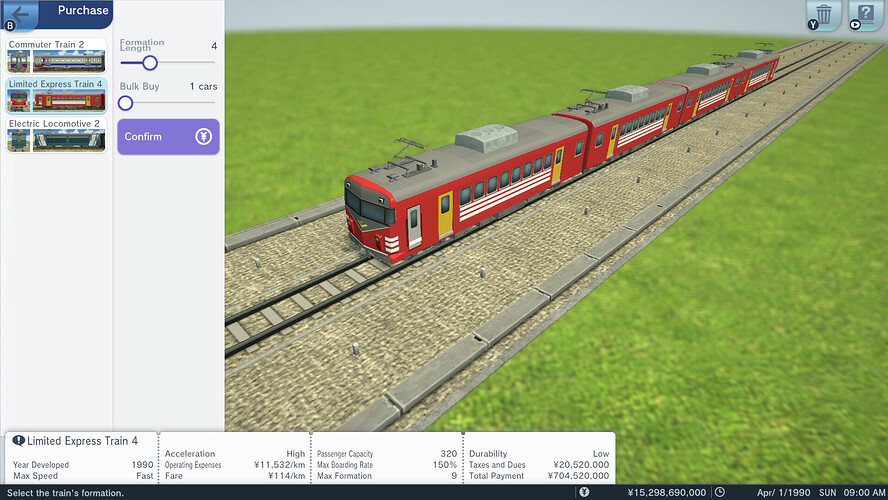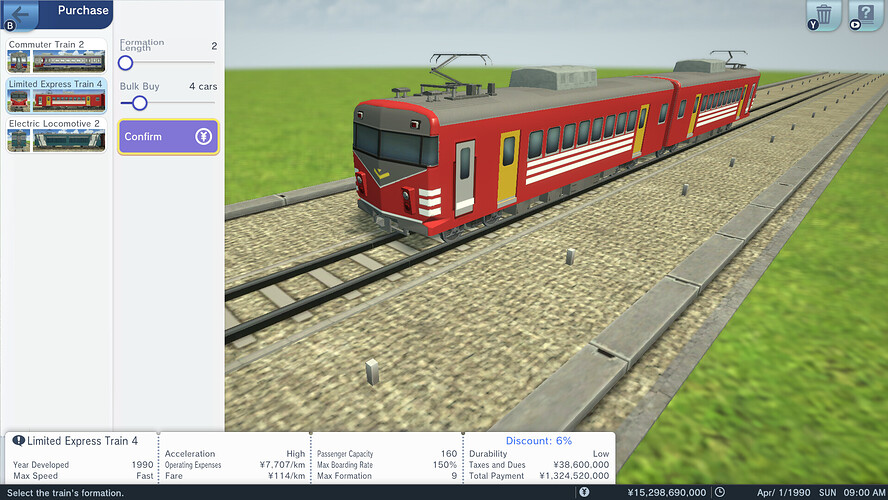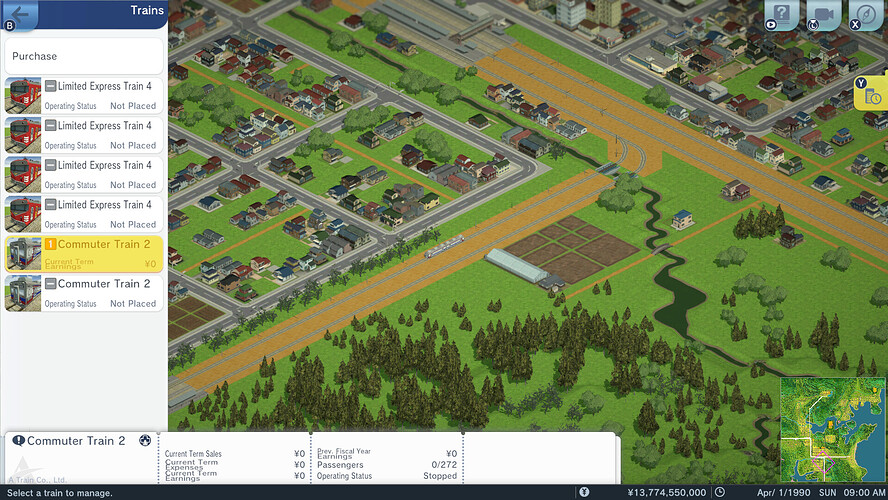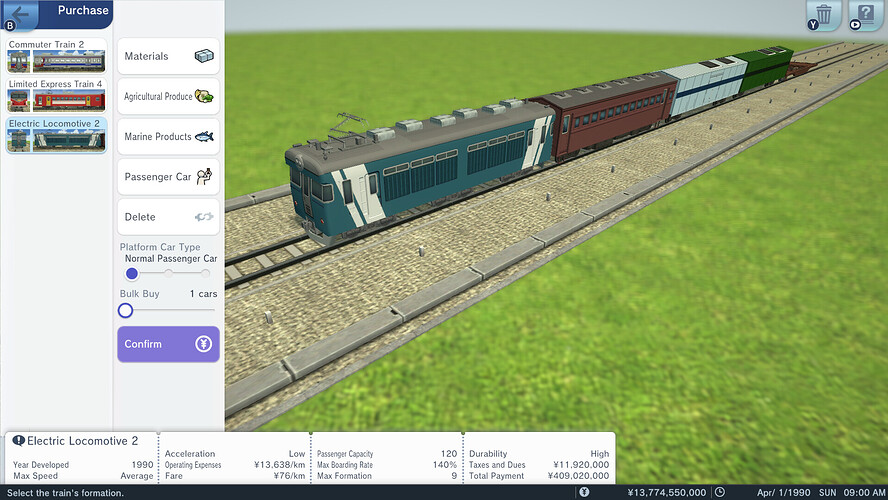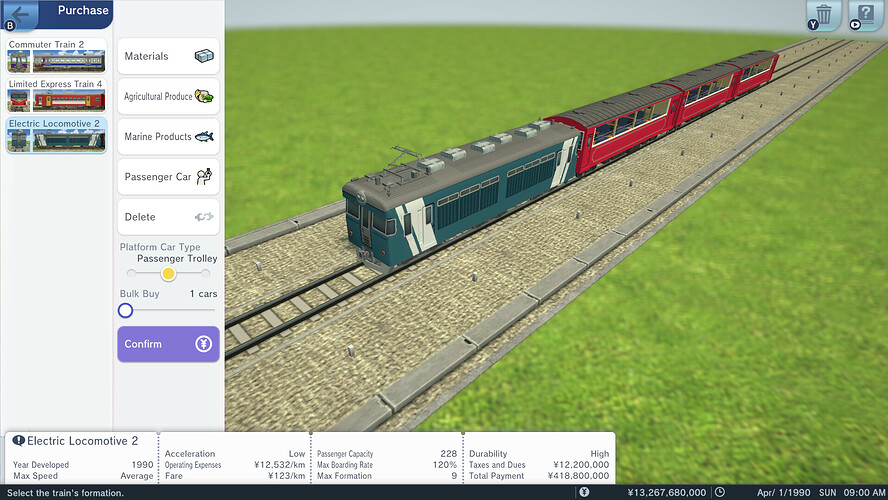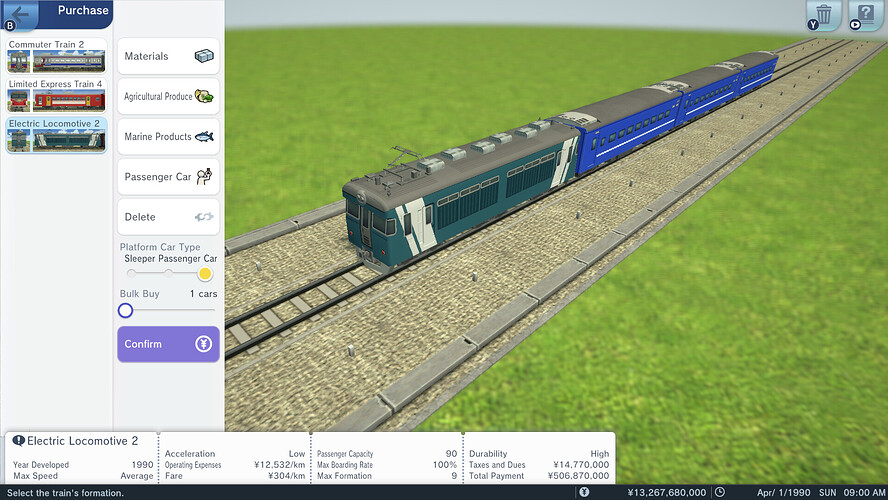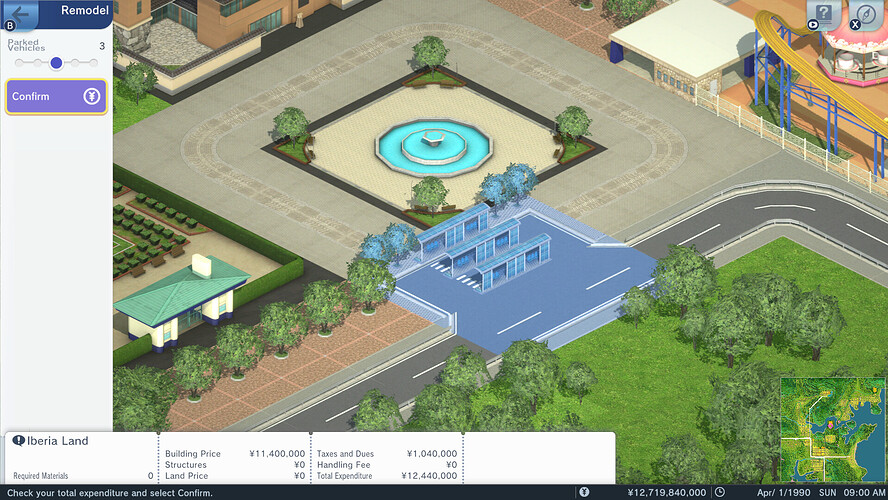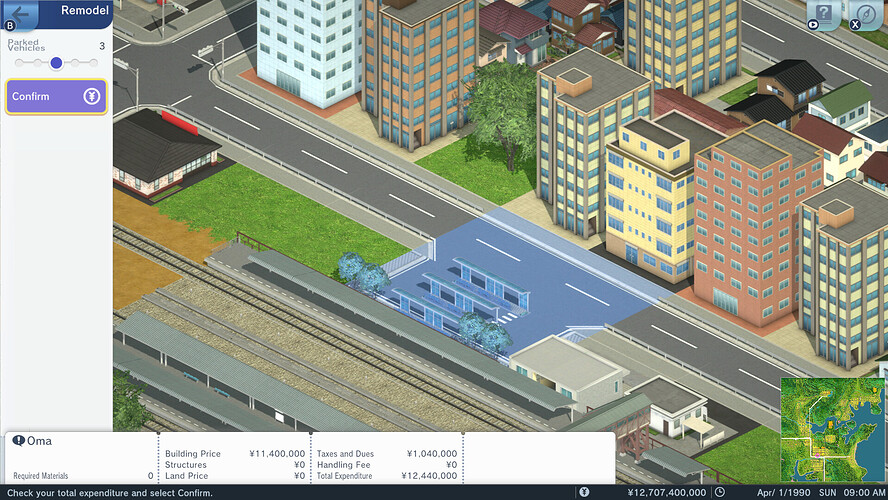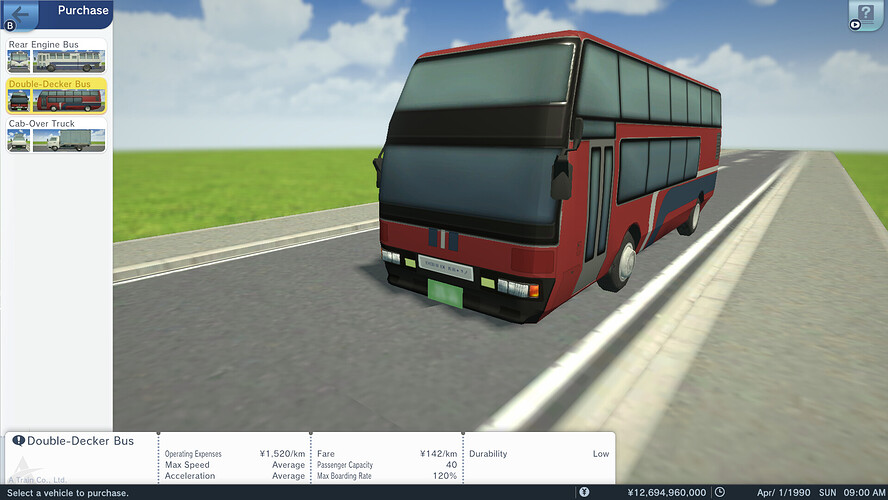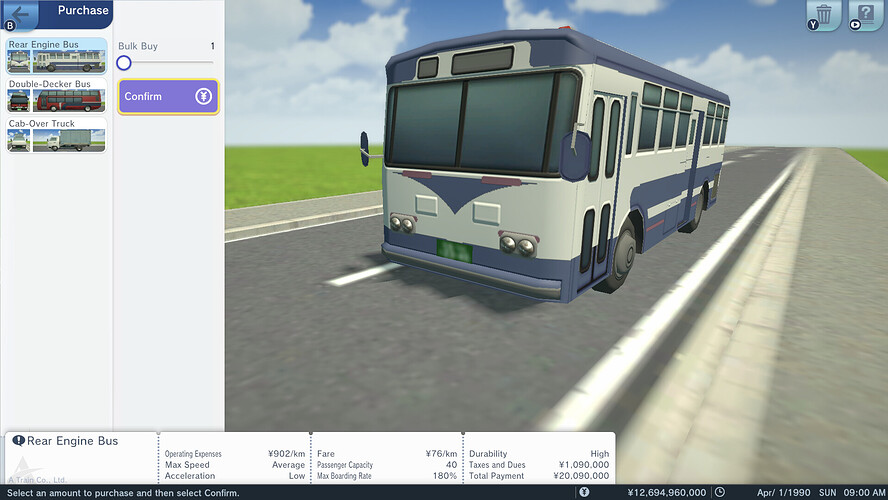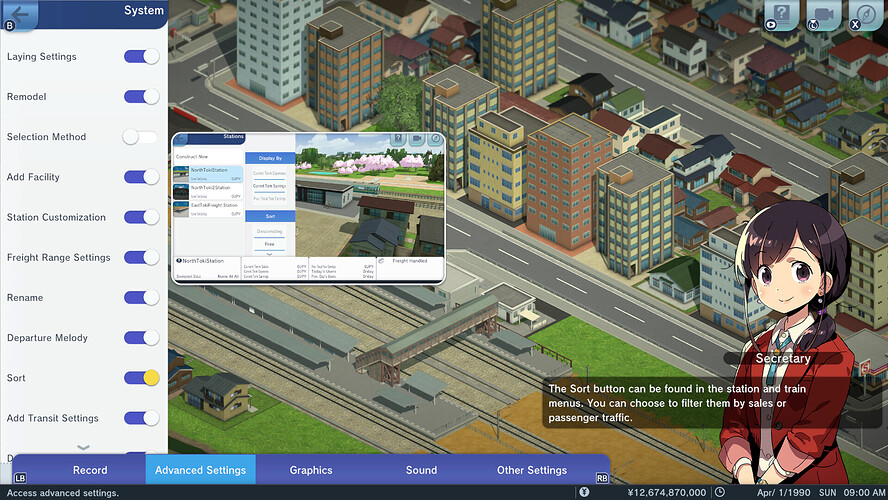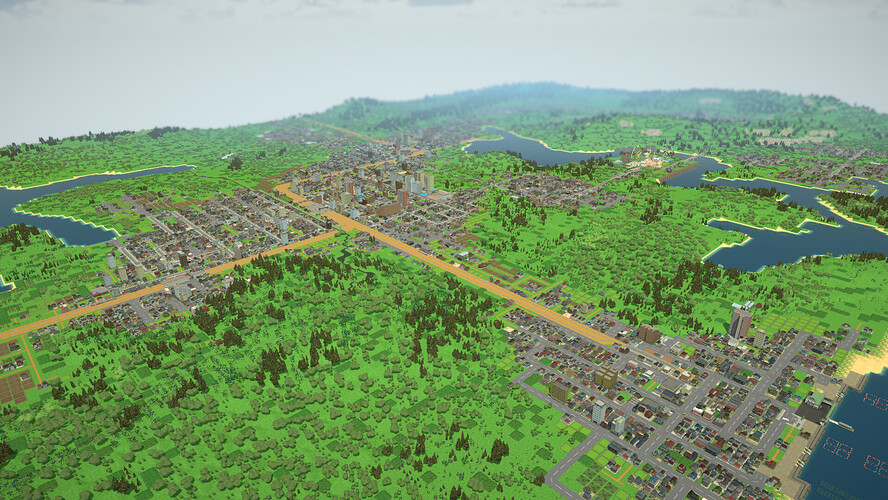Who knew you could spend so many words just discussing the acquisition of rolling stock and automobiles. Which must mean it’s time for another entry in Let’s Play City of Hopes & Dreams.
Today’s scheduled train service leaving for City of Hopes & Dreams is about to depart the station. Please ensure you have finished boarding the train and have your tickets ready for inspection by the conductor!
Let’s Play City of Hopes & Dreams - What good is transportation infrastructure without some vehicles?
Click to reveal...
Welcome back to the City of Hopes & Dreams scenario on the PC edition of A-Train: All Aboard! Tourism. When we last met we had just concluded laying the groundwork for our initial transportation network. Today will be all about making use of that infrastructure, doing some slight tweaks to it where necessary, and deciding upon the kinds of vehicles we are going to use to accomplish that goal.
So, settle on in as we procure a wide assortment of rolling stock and automobiles!
Our first step today will be to begin acquiring some new rolling stock to operate on our expanded railway infrastructure. To facilitate the transportation of tourists and other passengers to and from Tomano and Toyonami via the Oma and Shin Isoya stations we investigate buying some limited express trains. These trains will allow us to rapidly funnel tourists into the rest of our transportation network, such as our planned tourist service from Shin Isoya up to Sugio Onsen.
This is achievable thanks to their excellent top speed and acceleration characteristics, relative to the other categories of trains available and our pre-existing fleet of rolling stock. Having a max speed rating of fast allows the Limited Express Train 4 blueprint to complete a loop of the Toyonami to Oma and Tomano to Shin Isoya routes within just two hours. Thereby, allowing Limited Express Train 4 type trains to achieve more trips during that crucial morning (6am-ish to 11am-ish) time window whereby tourists travel into the region from off-map.
We have a couple of choices to decide upon while purchasing our limited express trains. Our company could operate several shorter trains, which would be cheaper in upfront costs but incur higher long-term costs via operational expenses. Or alternatively, we could operate fewer but longer trains, which would cost more upfront but be cheaper long-term due to lower operational expenses.
This parallels some of the decision making processes that have historically happened within the higher echelons of real-life railroad companies. The Union Pacific is littered with examples of the company trying to accomplish more with less, leading to the development of the famous 4-8-8-4 Union Pacific Big Boy and Union Pacific GTELs (Gas Turbine-Electric Locomotives). More powerful locomotives could haul longer consists and meant fewer locomotives and crews were required to operate the railroad, which cut down on operational expenses and increased profit margins for the Union Pacific.
In the end our company decides to prioritise the capacity to potentially schedule hourly services and procures four sets consisting of two cars each. The Toyonami to Oma route will be allocated two of these new limited express trains whilst the Tomano to Shin Isoya route will receive the remaining two sets.
Next, we will acquire an additional two-car set of the Commuter Train 2 type to operate alongside our existing commuter train. These two trains, of the suburban classification, will operate the route between Shin Isoya and Ajiro, with Oma station acting as their home station.
That purchase brings our company’s rolling stock up to a total of six trains. However, before we move onto scheduling some train schedules we have a couple of new locomotives to purchase as well.
Locomotives are the multi-functional workhorses of the railways able to haul consists of passengers, various types of freight, or a combination of both. To counterbalance this versatility; steam, diesel and electric locomotives tend to have higher operational costs compared to their passenger-only counterparts, the electric or diesel multiple units (EMU or DMU). However, when employed in the right situations locomotives can provide passenger services to areas that might be financially infeasible for EMU or DMU trains.
Our first locomotive purchase will be a purely freight focused train, consisting of eight agricultural produce wagons. This train will operate out of Isoya Agriculture and be responsible for hauling agricultural products to Tomano or Toyonami, depending on who is offering the better trade contract. Each wagon is able to hold two units of agricultural produce, allowing us to haul up to 16 units of agricultural produce per trip.
Next, we will configure our second locomotive for use as a passenger service. This train will run between the Shin Isoya station and Sugio Onsen station, servicing the scenic route that connects the two. The consist of our locomotive can be modified by clicking on the corresponding button on the GUI, with the delete button removing the last added car\wagon.
When adding passenger cars to a locomotive we can also adjust the Platform Car Type slider to change the type of passenger cars in use. There are a total of three car choices which each have their own unique capacity, max boarding rate, fare, and cost.
For the purposes of our tourist service between Shin Isoya and Sugio Onsen we assign our locomotive an initial consist of three sleeper passenger cars. Since the ridership of the route is expected to be predominantly tourists the small capacity of each sleeper passenger car should not be an issue. Meanwhile, the high passenger fare of ¥304 per kilometre traveled should allow our company to extract a healthy profit from the planned service.
Our company then moves onto purchasing three Cab-Over Truck type trucks to haul marine products from the Oima fishery. Sema has a large demand for marine products currently, which should keep our three lorries busy around the clock while the trade contracts are active. The Cab-Over Truck type is able to transport all the various resource types but hauls just one unit load at a time, compared to two unit loads per wagon achieved by our freight train. However, unlike a train’s consist, trucks do not require any modifications to carry different types of cargo, making them a cheap and versatile option for hauling freight.
Consequently, the loading bays at Oima Fishing Harbour have been expanded from two parking bays up to a total of three parking bays to handle the increase in lorry traffic.
Due to the numer of tourists expected to commute to Iberia Land, our company also takes the steps towards remodelling the bus stop from two bays up to a total of three bays. Consequently, allowing more buses to utilise the bus stop at Iberia Land. Which will make sure that no buses have to wait around for a free platform to appear, holding up local road traffic in the process.
Similar steps are also taken at the Oma bus stop for exactly the same reasons. The capacity of the bus services between Oma and Iberia Land are forecast to be overwhelmed with just two buses operating. Thus, necessitating the expansion of our company’s bus facilities to allow for the operation of a third bus service on the Oma to Iberia Land route.
Since strength of urban development around stations and stops depends upon the number of daily commuters. We want to ensure that a sufficient number of commuters can board and alight at the East Oma, Oma School, and Old Isoya bus stops. Ensuring we have sufficient passenger capacity on the Oma to Iberia Land route is not just potentially good short-term business but also will benefit our company in the long-term, as the population steadily grows from further urbanisation.
Our company has two options when it comes to expanded our existing bus fleet of two vehicles. One option is this Double-Decker Bus blueprint randomly chosen, at the start of the scenario, to be carried across from a pre-existing save state. It features a higher fare per passenger per kilometer traveled but at the cost of a lower overall passenger capacity.
Our other option, which always comes with the City of Hopes and Dreams scenario, is this Rear Engine Bus blueprint. Which features a higher overall passenger capacity at the cost of a lower fare per passenger per kilometer traveled, and slightly worse acceleration. It is also roughly half as expensive as buying the Double-Decker Bus, another factor in its favour.
Due to short-term and long-term ridership projections, our company opts to go with the additional capacity of the Rear Engine Bus blueprint. Thereby, expanding our bus fleet with one additional rear engine bus, to complement the two others we already own.
Using the Advanced Settings tab, unlocked part way through the tutorial of City of Hopes and Dreams if playing the scenario on Easy difficulty, we can enable several handy optional features. For organisational purposes, the Rename and Sort functions can be a blessing to have enabled.
After utilising the Rename and Sort features, here is our current inventory of rolling stock and automobiles. Whilst you can sort lists in a number of different ways, my current favourite method is to group vehicles by route, departure time, and the frequency with which I may want to adjust their settings.
Unfortunately, that is all we have time for today and so, alas, this is where we must conclude. I hope you enjoyed our foray into purchasing various rolling stock options and automobiles, with a dash of infrastructure fine tuning. Please do continue to join us, as next time we let the clock run so that our stations complete construction and go about organising the operational plans (timetables) of all our vehicles.
We will leave you today with a potential glimpse into the future, a forecast of what is yet to come. Until we next meet aboard the A-Train, the staff at A Train Com., Ltd. would like to wish you a safe and prosperous journey!

